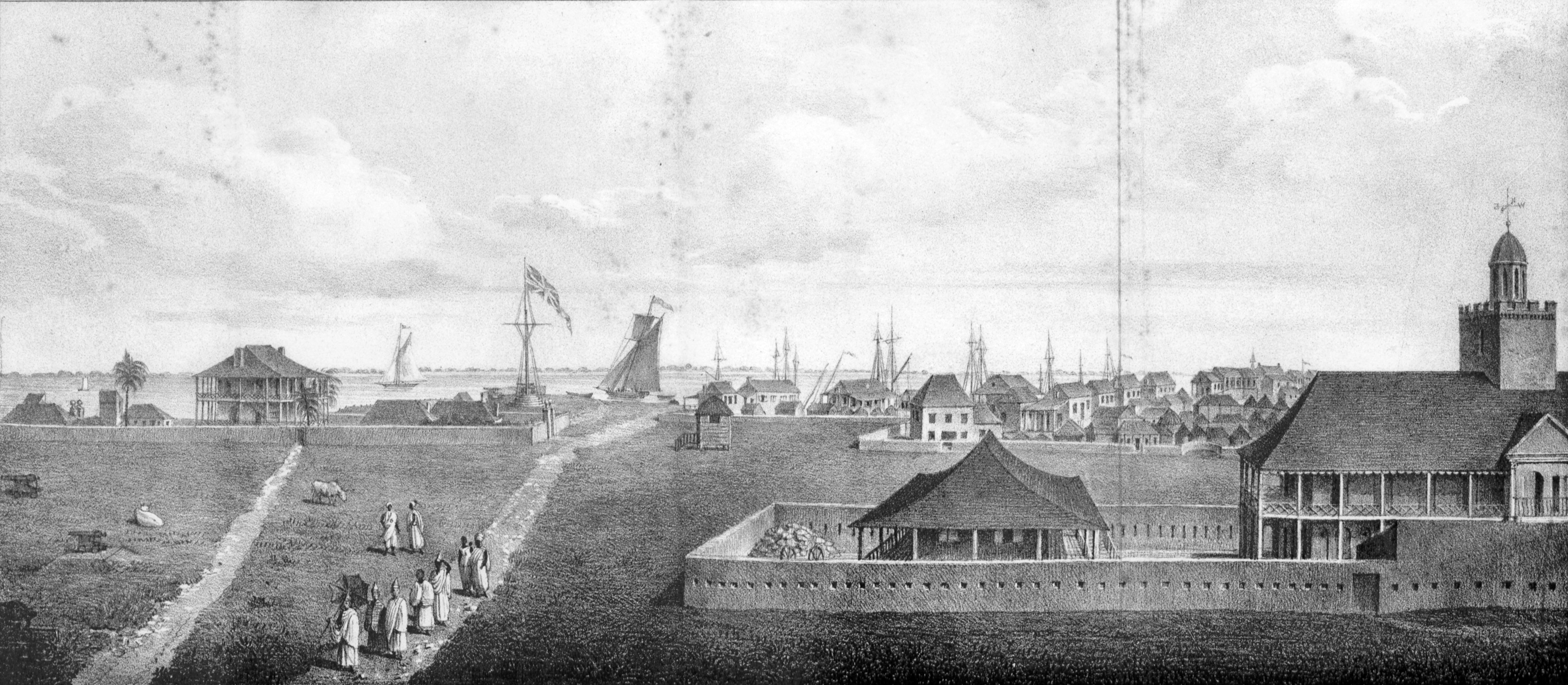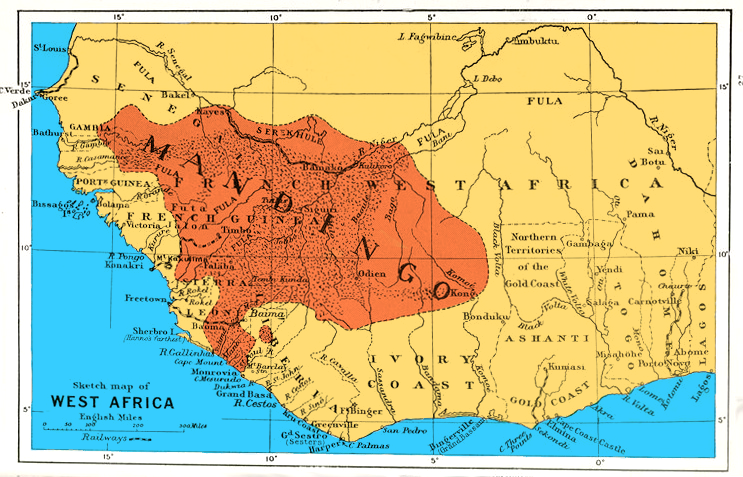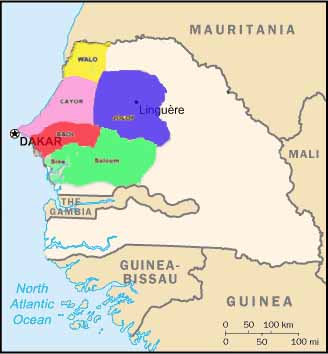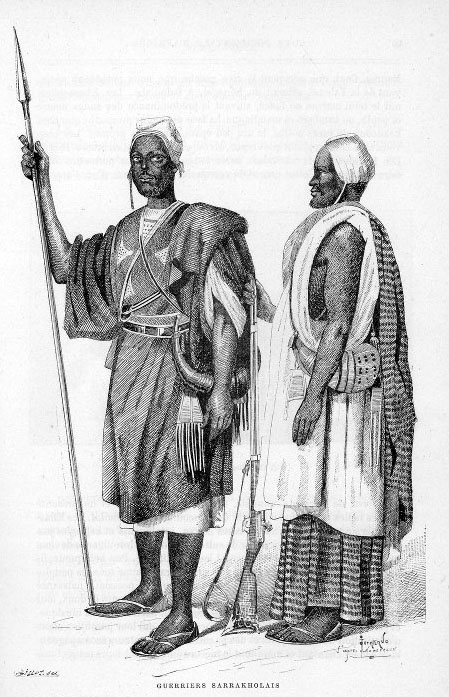|
Gambia
The Gambia, officially the Republic of The Gambia, is a country in West Africa. Geographically, The Gambia is the List of African countries by area, smallest country in continental Africa; it is surrounded by Senegal on all sides except for the western part, which is bordered by the Atlantic Ocean.Hoare, Ben. (2002) ''The Kingfisher A–Z Encyclopedia'', Kingfisher Publications. p. 11. . Its territory is on both sides of the lower reaches of the Gambia River, which flows through the centre of the country and empties into the Atlantic. The national namesake river demarcates the elongated shape of the country, which has an area of and a population of 2,769,075 people in 2024 which is a 47% population increase from 2013. The capital city is Banjul, which has the most extensive metropolitan area in the country. The second and third-largest cities are Serekunda and Brikama. Arab Muslims, Arab Muslim merchants traded with indigenous West Africans in The Gambia throughout the 9th ... [...More Info...] [...Related Items...] OR: [Wikipedia] [Google] [Baidu] |
Serrekunda
Serekunda (or Serrekunda; ) is a major city and the largest metropolitan area in The Gambia. It is situated close to the Atlantic coast, on the Gambia River, near the capital, Banjul. Serekunda and Banjul form an urban area known as the Kombos, with about half of the population of the Gambia. Serekunda was named for Sayerr Jobe, who founded it in the 19th century. It merged with several villages into a larger urban area. Banjul's growth has been restricted due to being a small island, leading to Serekunda growing in population and businesses moving there from Banjul. Serekunda has been the site of political protests, and candidates from several parties have won seats. Since the 1980s, Serekunda has been a regional centre of the Tablighi Jamaat religious movement. Serekunda's market is the largest in the country. Along the coast, the Senegambia Strip is a popular place for foreign tourists, including sex tourists. Gambian wrestling is a popular sport, and the city has multipl ... [...More Info...] [...Related Items...] OR: [Wikipedia] [Google] [Baidu] |
Flag Of The Gambia
The national flag of The Gambia consists of three horizontal red, blue and green bands separated by two thin white stripes. Adopted in 1965 to replace the British Blue Ensign Defacement (flag), defaced with the arms of the Gambia Colony and Protectorate, it has been the national flag, flag of the Republic of the Gambia since the country gained independence that year. It remained unchanged throughout the Gambia's seven-year Senegambia Confederation, confederation with Senegal. History The British first arrived in what is now modern-day Gambia in 1661, when they conquered Kunta Kinteh Island, James Island. They proceeded to construct forts around the confluence of the Gambia River with the Atlantic Ocean, and gradually expanded their control upstream. This area became a Gambia Colony and Protectorate, protectorate in the 1820s under the jurisdiction of History of Sierra Leone#Colonial era (1808–1961), Sierra Leone, and eventually emerged as a separate crown colony of the Un ... [...More Info...] [...Related Items...] OR: [Wikipedia] [Google] [Baidu] |
Banjul
Banjul (, (US) and ), officially the City of Banjul, is the capital city of The Gambia. It is the centre of the eponymous administrative division which is home to an estimated 400,000 residents, making it The Gambia's largest and most densely populated metropolitan area. The city Banjul is located on St Mary's Island (Banjul Island), where the Gambia River enters the Atlantic Ocean. The population of the city proper is 31,301, with the Greater Banjul Area, which includes the City of Banjul and the Kanifing Municipal Council, at a population of 413,397 (2013 census). The island is connected to the mainland to the west and the rest of Greater Banjul Area via bridges. There are also ferries linking Banjul to the mainland at the other side of the river. From the 19th century until 24 April 1973, the city was known as Bathurst. Etymology There are several etymologies for 'Banjul.' One traditional history recounts that Bandjougou, son of Barafin, came to the island after fleeing t ... [...More Info...] [...Related Items...] OR: [Wikipedia] [Google] [Baidu] |
Serer People
The Serer people (''Serer language, Serer proper'': Seereer or Sereer) are a West African ethnoreligious groupGastellu, Jean-Marc, ''Petit traité de matrilinarité. L'accumulation dans deux sociétés rurales d'Afrique de l'Ouest'', Cahiers ORSTOM, série Sciences Humaines 4 (1985) [in] Gastellu, Jean-Marc, ''Matrilineages, Economic Groups and Differentiation in West Africa: A Note'', O.R.S.T.O.M. Fonds Documentaire (1988), pp 1, 2–4 (pp 272–4), 7 (p 277/ref>Marguerite Dupire, Dupire, Marguerite, ''Sagesse sereer: Essais sur la pensée Ndut people, sereer ndut'', KARTHALA Editions (1994). For ''tim'' and ''den yaay'' (see p. 116). The book also deals in depth about the Serer matriclans and means of succession through the matrilineal line. See pp. 38, 95–99, 104, 119–20, 123, 160, 172–74,/ref> They fought against jihads in the 19th century, and subsequently opposed French colonial rule - resulting in Serer victory at the famous Battle of Djilass (13 May 1859), and the Fre ... [...More Info...] [...Related Items...] OR: [Wikipedia] [Google] [Baidu] |
For The Gambia Our Homeland (instrumental)
"For The Gambia Our Homeland" is the national anthem of the Gambia. National anthem of the Gambia, written by Virginia Julia Howe and composed by Jeremy Frederic Howe , adopted after an international competition before independence in 1965 History In the lead-up to The Gambia's independence from the United Kingdom on 18 February 1965, a National Anthem Selection Committee was set up to accept submissions for a national anthem for the country. The Committee would ultimately receive three submissions. One submission, by Reverend John Colley Faye, although acknowledged as "superb" in content, was rejected for being too long, with the Committee preferring something more to the point and easy to memorise. Mandinka musician Jali Nyama Suso was approached by the government to compose an entry. He responded that he would base his proposal on a traditional Mandinka tune dedicated to Foday Kabba Dumbuya (or Fodee Kaba Dumbuya), a Muslim reformer and warrior remembered for his conque ... [...More Info...] [...Related Items...] OR: [Wikipedia] [Google] [Baidu] |
Mandinka People
The Mandinka or Malinke are a West African ethnic group primarily found in southern Mali, The Gambia, southern Senegal and eastern Guinea. Numbering about 11 million, they are the largest subgroup of the Mandé peoples and one of the List of ethnic groups of Africa, largest ethnolinguistic groups in Africa. They speak the Manding languages in the Mande language family, which are a ''lingua franca'' in much of West Africa. They are predominantly Subsistence agriculture, subsistence farmers and live in rural villages. Their largest urban center is Bamako, the capital of Mali. The Mandinka are the descendants of the Mali Empire, which rose to power in the 13th century under the rule of king Sundiata Keita, who founded an empire that would go on to span a large part of West Africa. They migrated west from the Niger River in search of better agricultural lands and more opportunities for conquest. Nowadays, the Mandinka inhabit the West Sudanian savanna region extending from The Gambia ... [...More Info...] [...Related Items...] OR: [Wikipedia] [Google] [Baidu] |
Wolof People
The Wolof people () are a Niger-Congo peoples, Niger-Congo ethnic group native to the Senegambia, Senegambia region of West Africa. Senegambia is today split between western Senegal, northwestern the Gambia, Gambia and coastal Mauritania; the Wolof form the largest ethnic group within Senegambia. In Senegal as a whole, the Wolof are the largest ethnic group (~39.7%), while elsewhere they are a minority. They Endonym and exonym, refer to themselves as ''Wolof'' and speak the Wolof language, in the West Atlantic languages, West Atlantic branch of the Niger–Congo family of languages; English inherited ''Wolof'' as both the adjectival ethnonym and the name of the language. Their early history is unclear. The earliest documented mention of the Wolof is found in the records of 15th-century, Portuguese-financed Italian traveller Alvise Cadamosto, who mentioned well-established Islamic Wolof chiefs advised by Muslim counselors. The Wolof belonged to the medieval-era Wolof Empire of the ... [...More Info...] [...Related Items...] OR: [Wikipedia] [Google] [Baidu] |
Jola People
The Jola or Diola (endonym: Ajamat) are an ethnic group found in Senegal, the Gambia, and Guinea-Bissau. Most Jola live in small villages scattered throughout southern Senegal, especially in the Lower Casamance region. The main dialect of the Jola language, Fogni, is one of the six national languages of Senegal. Their economy has been based on wet rice cultivation for at least one thousand years. This system has been characterised "one of the most significant examples of 'agrarian civilizations' in West Africa". However, the Jola probably reached the Lower Casamance region in the 14th century, assimilating the previous Bainuk people and their rice tradition. In colonial times, the Jola began to cultivate peanuts as a cash crop in the drier forests. Other activities include palm wine tapping, honey collecting, livestock rearing and the production of other crops such as sweet potatoes, yams and watermelon. The traditional religion of the Jola is animism, which is practise ... [...More Info...] [...Related Items...] OR: [Wikipedia] [Google] [Baidu] |
Wolof Language
Wolof ( ; , ) is a Niger–Congo language spoken by the Wolof people in much of the West African subregion of Senegambia that is split between the countries of Senegal, The Gambia and Mauritania. Like the neighbouring languages Serer and Fula, it belongs to the Senegambian branch of the Niger–Congo language family. Unlike most other languages of its family, Wolof is not a tonal language. Wolof is the most widely spoken language in Senegal, spoken natively by the Wolof people (40% of the population) but also by most other Senegalese as a second language. Wolof dialects vary geographically and between rural and urban areas. The principal dialect of Dakar, for instance, is an urban mixture of Wolof, French, and Arabic. ''Wolof'' is the standard spelling and may also refer to the Wolof ethnicity or culture. Variants include the older French , , or , which now typically refers either to the Jolof Empire or to jollof rice, a common West African rice dish. Now-archaic forms incl ... [...More Info...] [...Related Items...] OR: [Wikipedia] [Google] [Baidu] |
Soninke People
The Soninke (Sarakolleh) people are a West African Mande languages, Mande-speaking ethnic group found in Mali, southern Mauritania, eastern Senegal, The Gambia, and Guinea (especially Fouta Djallon). They speak the Soninke language, also called the Serakhulle or Azer language, which is one of the Mande languages. Soninke people were the founders of the ancient Ghana Empire, empire of Ghana or Wagadou c. 200–1240 CE, Subgroups of Soninke include the Jakhanke, Maraka and Soninke Wangara, Wangara. When the Ghana empire was destroyed, the resulting diaspora brought Soninkes to Mali, Mauritania, Senegal, Gambia, Burkina Faso, Côte d'Ivoire, Guinée-Conakry, modern-day Republic of Ghana, Kano in Nigeria, and Guinea-Bissau where some of this trading diaspora was called Wangara, leading to the saying “when Americans landed on the moon, a Soninke was already there” in Senegal, with other versions across West Africa. Predominantly Muslims, the Soninke were one of the early ethnic gr ... [...More Info...] [...Related Items...] OR: [Wikipedia] [Google] [Baidu] |
Gambian Sign Language
Gambian Sign Language is a national sign language used in Gambia The Gambia, officially the Republic of The Gambia, is a country in West Africa. Geographically, The Gambia is the List of African countries by area, smallest country in continental Africa; it is surrounded by Senegal on all sides except for ... by the deaf community there. The only school for deaf children in the Gambia, St John's School for the Deaf, was set up by a Catholic priest from Ireland. Dutch Sign Language was introduced to the school along with British Sign Language which developed into Gambian Sign Language, incorporating some indigenous gestures used by the general population. Unlike much of West Africa, American Sign Language was not introduced to the Gambia until much later so the deaf community is not familiar with American Sign Language. External linksGambian Association of the Deaf & Hard of Hearing French Sign Language family Languages of the Gambia {{sign-lang-stub ... [...More Info...] [...Related Items...] OR: [Wikipedia] [Google] [Baidu] |






